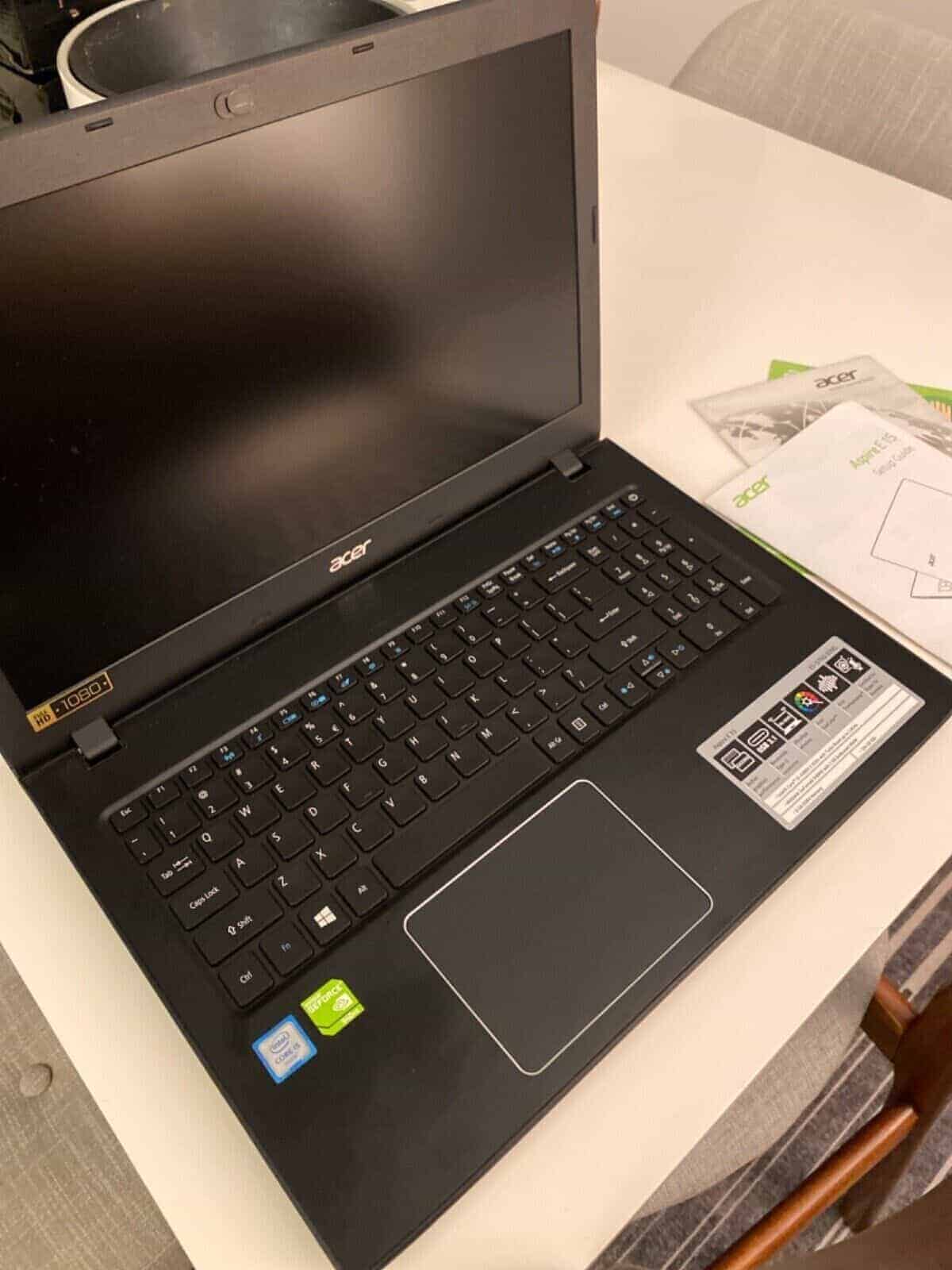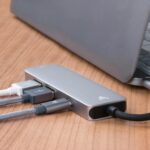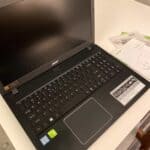Is your Acer laptop refusing to turn on? This common issue can be frustrating, especially when you need your computer for work or school. Many Acer laptop owners face this problem, but the good news is that there are several simple fixes you can try before seeking professional help.
Often, an Acer laptop that won’t power on can be fixed by disconnecting all power sources, holding the power button for about 60 seconds, and then reconnecting the power. This process, sometimes called a power drain or hard reset, helps clear any residual power that might be causing issues with the startup process. Other simple troubleshooting steps include checking your power adapter and battery connections to make sure everything is properly seated.
Sometimes the issue is related to hardware problems like a faulty power button or dead battery. In other cases, software issues might prevent your laptop from turning on properly. Before assuming the worst, try the basic fixes like disconnecting external devices or forcing a shutdown by holding the power button when you see loading dots.
Step 1: Check the Power Source
Start with the basics—your Acer laptop might not be getting power.
Things to check:
- Power Outlet: Plug another device into the same outlet to verify it’s working.
- Charger and Cable: Look for any frays or bent connectors. If possible, test with another compatible charger.
- Power Port: Inspect your laptop’s charging port for dust, damage, or looseness.
| Power Source Checklist | Working? | Notes |
|---|---|---|
| Wall outlet | ✅ / ❌ | |
| Charger | ✅ / ❌ | Look for LED indicator |
| Charging port | ✅ / ❌ | Check for debris or wiggle |
If everything appears functional but the laptop still won’t respond, move to the next step.
Step 2: Perform a Hard Reset
Sometimes static electricity or a system hiccup can prevent your Acer from powering on.
For laptops with a removable battery:
- Remove the battery.
- Unplug the charger.
- Hold down the power button for 30 seconds.
- Reinsert the battery and plug in the charger.
- Try turning it on.
For laptops with a non-removable battery:
- Unplug the charger.
- Press and hold the power button for 30–60 seconds.
- Reconnect the charger and try powering on.
This forces the system to discharge and can resolve a freeze caused by hardware locks.
Step 3: Check for Signs of Life
Determine if the issue is related to power delivery or display.
| Indicator | What It Means |
|---|---|
| Power LED lights up | Power is reaching the motherboard |
| Fan noise | BIOS or hardware is attempting to initialize |
| Keyboard backlight | System is likely booting |
| Screen remains black | Possible display issue or failed boot |
If you hear fans or see lights but no image, the screen or GPU might be the issue. Try connecting to an external monitor via HDMI or USB-C.
Step 4: Try an External Display
Connect your Acer laptop to an external monitor or TV.
What to do:
- Plug in an HDMI or USB-C cable.
- Power on the external monitor.
- Turn on your laptop.
- Press Fn + F5 (or Fn + another F-key) to switch displays.
If the external monitor shows your desktop, the internal display or its connection may be the problem.
Step 5: Remove External Devices
Peripherals can interfere with boot processes.
Unplug the following:
- USB drives
- External keyboards or mice
- Printers or hubs
- SD cards
Once unplugged, try powering on the laptop again. A corrupted boot device or driver conflict can stop the system from initializing correctly.
Step 6: Reseat RAM and Storage (If Possible)
Loose memory or SSD connections can cause a no-boot issue.
⚠️ Only attempt this if you’re comfortable opening the back panel of your laptop.
To reseat components:
- Power off and unplug the laptop.
- Remove the back cover.
- Locate the RAM sticks and SSD.
- Remove and reinsert them firmly.
- Reattach the back cover and try to power on.
This often resolves hardware seating problems, especially after a drop or jolt.
Step 7: Use the Battery Reset Pin (For Some Acer Models)
Some Acer laptops include a small battery reset pinhole on the bottom.
How to use:
- Look for a tiny pinhole labeled “Reset” or “Battery Reset.”
- Insert a paperclip and hold for 5–10 seconds.
- Plug in the charger and try powering on the laptop.
This resets the embedded controller and can restore functionality.
Step 8: BIOS or Firmware Corruption
If the laptop powers on briefly or shows the Acer logo before going dark again, it might be a corrupted BIOS.
What you can try:
- BIOS Recovery Mode: Some Acer laptops allow BIOS recovery from a USB drive. Visit Acer’s support site, download the BIOS update file, and follow instructions for creating a recovery USB.
- Contact Acer Support: If BIOS recovery is needed and can’t be initiated manually, a service center visit may be required.
Troubleshooting Summary Table
| Issue | Most Likely Cause | Suggested Fix |
|---|---|---|
| No power, no lights | Dead charger or outlet | Try another charger/outlet |
| Power light on, screen black | Display issue or bad GPU | Test external display |
| Laptop turns on, then off | Overheating or BIOS issue | Hard reset or check fan vents |
| Battery works, no charging | Charger or power jack issue | Try new charger or service port |
| No boot, fans spin | RAM/SSD issue | Reseat memory and storage |
If all else fails, professional repair may be necessary—especially for motherboard or BIOS-level issues.
Key Takeaways
- Disconnecting the battery and charger, then holding the power button for 30-60 seconds often resolves power issues with Acer laptops.
- Check your power adapter and connections before assuming a serious hardware failure.
- Try forcing multiple shutdowns when you see loading indicators as this can break a boot cycle issue.
Initial Checks
When your Acer laptop won’t turn on, starting with some basic troubleshooting steps can often resolve the issue quickly without needing technical help.
Verifying Power Supply and Battery Charge
First, check if your Acer laptop is getting power. Connect the AC adapter directly to a wall outlet rather than a power strip or extension cord. Look for a small light on the adapter or where it connects to the laptop – this should glow when plugged in.
If you don’t see any lights, try a different outlet. The problem might be with your power source, not the laptop.
For laptops with removable batteries, take out the battery and try running the laptop on AC power only. This can help determine if the battery is the problem.
Press and hold the power button for 30 seconds with the laptop unplugged and battery removed. This discharges residual power that might be causing issues.
Check the battery charge indicator if visible. Some Acer models show battery status even when powered off.
Inspecting Cable and Power Cord Integrity
Examine your power cable for any visible damage. Look for fraying, cuts, or bends that might interrupt power flow.
Check both ends of the cable – the wall plug and the connector that goes into your laptop. Bent pins or debris in the laptop’s power port can prevent proper connection.
Try wiggling the adapter connection gently while plugged in. If the power light flickers, the adapter or port might be damaged.
If possible, test with a different compatible charger. Power adapters can fail internally with no visible damage.
Make sure the voltage output of your charger matches your Acer laptop’s requirements. Using the wrong adapter can prevent startup.
Assessing External Damage and Indicator Lights
Look for physical damage on your laptop that might affect power-up. Check for liquid spills or impact damage.
Watch the indicator lights when you press the power button. Even if the screen stays black, lights for power, battery, or hard drive activity can provide clues.
Listen for fan noise or startup sounds. Your laptop might be turning on but having display problems.
Remove all external devices (USB drives, external monitors, etc.). Sometimes these can interfere with the startup process.
If your laptop gets warm when you try to power it on but doesn’t display anything, it might be starting but having screen issues. Try connecting to an external monitor to check if this is the case.
Basic Troubleshooting Steps
When your Acer laptop won’t turn on, several simple solutions might fix the problem before you need professional help. These steps can solve many common power issues without requiring technical skills or special tools.
Performing a Power Reset
A power reset can fix many laptop problems by draining residual electricity from the system. First, disconnect the power adapter and remove any external devices. Then take out the battery if your model allows it.
Press and hold the power button for at least 30 seconds. This helps discharge any electricity still in the components. Some technicians recommend holding it for up to a minute for the best results.
After the reset, reconnect the battery and plug in the power adapter. Try turning on your laptop again. This simple process often works because it clears temporary electrical issues that prevent normal startup.
If your laptop has a built-in battery that can’t be removed, you can still do a modified reset. Unplug the power adapter, hold down the power button for 30 seconds, then reconnect power and try again.
Booting in Safe Mode and System Restore
If your laptop powers on but doesn’t boot normally, try entering Safe Mode. Turn on the laptop and immediately press F8 repeatedly (some Acer models use F2 or Del instead). This brings up the Advanced Boot Options menu.
Select “Safe Mode” using the arrow keys and press Enter. Safe Mode loads only essential drivers and services, which can help if software issues are causing the problem.
Once in Safe Mode, you can run System Restore to return your computer to an earlier working state. Go to:
- Start Menu
- Type “System Restore”
- Follow the wizard to choose a restore point from when your laptop worked properly
System Restore doesn’t affect your personal files but removes recently installed programs that might be causing conflicts.
Checking External Devices and Peripherals
External devices can sometimes prevent your Acer laptop from turning on properly. Disconnect everything connected to your laptop including:
- USB devices
- External monitors
- Memory cards
- Printers
- Bluetooth devices
- External hard drives
Try powering on your laptop with only the power adapter connected. If it turns on, reconnect devices one at a time to identify which might be causing the problem.
Some devices can draw too much power or cause conflicts that prevent normal startup. This is especially true for older peripherals or those without updated drivers.
If your laptop turns on after removing external devices, you may need to update drivers for those devices before connecting them again.
Hardware Checks and Solutions
When your Acer laptop won’t turn on, hardware issues are often the culprit. Checking components systematically can help pinpoint and fix the problem without needing professional repair.
Diagnosing Display and Monitor Issues
Sometimes an Acer laptop may be running but not displaying anything on screen. First, check if the power LED lights up when you press the power button. If it does, your laptop might be on but having display issues.
Try connecting an external monitor using the HDMI or VGA port. If the external display works, your laptop’s screen or display cable may be faulty.
Adjust the brightness using function keys (usually Fn + arrow keys) as the screen might simply be dimmed all the way down.
Look for any physical damage on the screen. Cracks or visible damage will require professional repair.
For flickering displays, update your graphics drivers or check for loose connections between the display and motherboard.
Testing RAM and Storage Drive Functionality
RAM and storage problems can prevent your Acer laptop from booting properly. To test RAM, turn off your laptop and remove the bottom panel.
Carefully take out the RAM sticks, clean the gold contacts with a soft eraser, and reinsert them firmly. If you have multiple RAM sticks, try booting with just one at a time to identify if one is faulty.
For storage issues, listen for unusual clicking sounds from your hard drive, which often indicate failure. No sound at all from the drive when powering on could mean it’s completely dead.
SSD drives don’t make noise but can still fail. Try removing and reinstalling your storage drive to ensure proper connection.
Boot into BIOS (usually by pressing F2 during startup) to verify if your storage drive is detected by the system.
Identifying BIOS and Boot Problems
BIOS issues commonly cause startup failures in Acer laptops. Reset the BIOS by removing the laptop battery and power adapter, then holding the power button for 30 seconds to discharge residual power.
Replace the CMOS battery if your laptop is older than 3-4 years, as a dead CMOS battery prevents proper BIOS function.
Check for BIOS error beeps when turning on your laptop. Different beep patterns indicate specific hardware failures:
- One beep: Normal boot
- Two beeps: RAM failure
- Three beeps: Motherboard issue
- Continuous beeps: Power supply problem
Create a bootable recovery disk using another computer if you suspect corrupted system files. Most Acer laptops support F12 boot menu to select alternative boot devices.
If all else fails, try booting into Safe Mode by pressing F8 during startup to rule out software-related issues.
Software-Related Problems and Fixes
Software issues can often prevent your Acer laptop from turning on properly. These problems might appear as if the laptop isn’t powering on at all, when in reality, it’s just not booting correctly.
Scanning for and Removing Viruses
Certain viruses can block your Acer laptop from starting up correctly. If your laptop shows signs of life (lights, fan noise) but won’t display anything, malware might be the culprit.
To address this:
- Boot in Safe Mode: Press F8 repeatedly during startup until the Advanced Boot Options appear
- Run virus scan: Use Windows Defender or another antivirus program
- Remove threats: Follow the instructions to quarantine or delete malicious files
If you can’t reach Safe Mode, try using a recovery drive. Create one on another computer using the same Windows version, then boot your Acer from this drive. Run a thorough virus scan to catch deep-rooted malware that might be preventing normal startup.
Some viruses attack the master boot record (MBR). In this case, you’ll need to use the Command Prompt from a recovery environment to repair it with the “bootrec /fixmbr” command.
Resolving Driver Conflicts and Updates
Outdated or corrupted drivers can prevent your Acer laptop from turning on properly. Driver conflicts often occur after Windows updates or software installations.
Try these fixes:
- Boot into Safe Mode: Press F8 during startup
- Roll back recent driver updates: Go to Device Manager, right-click the problematic device, select Properties, and click “Roll Back Driver”
- Update essential drivers: Check for updates to graphics, chipset, and power management drivers
For serious driver problems, use System Restore to go back to a working state. Access it through Advanced Startup options by holding Shift while clicking Restart, then navigate to Troubleshoot > Advanced Options > System Restore.
Graphics driver issues are especially common culprits. If your screen stays black but you hear the laptop running, try connecting an external monitor to see if you can access Windows and update your display drivers.
Restoring Laptop to Previous Configuration
When software changes cause startup failures, returning to a previous working state can fix your Acer laptop.
System Restore options:
- Boot to Advanced Startup (hold Shift while clicking Restart)
- Select Troubleshoot > Advanced Options > System Restore
- Choose a restore point from before the problem started
If System Restore isn’t accessible, try Automatic Repair:
- Force-restart your laptop by holding the power button for 10 seconds
- Turn it on and immediately off three times in a row
- On the fourth startup, Windows should enter Automatic Repair mode
Factory Reset (as a last resort):
From Advanced Startup, choose Troubleshoot > Reset this PC. This will erase your data but fix most software issues preventing startup.
Back up important files first whenever possible using a bootable USB drive if you can’t access your system normally.
Advanced Diagnostic Steps
When basic troubleshooting fails to revive your Acer laptop, it’s time to try more technical approaches that can help identify and fix the underlying issues. These methods can help bypass common startup problems or determine if hardware components are functioning properly.
Utilizing Keyboard Shortcuts and Special Functions
Most Acer laptops have built-in diagnostic tools accessed through keyboard shortcuts. The F12 key often serves as a boot menu key that lets you change startup options. Try pressing it repeatedly immediately after pressing the power button.
Some Acer models use different function keys:
- F2: BIOS setup access
- Alt + F10: Recovery environment (on some models)
- Fn + ESC: System information
If your laptop powers on but shows no display, try the brightness keys (usually Fn + right/left arrow) as the screen might simply be dimmed. Some models have a special key combination (Fn + F6 on many Acers) to toggle the display mode.
For complete system resets, try holding the power button for 30 seconds with the battery removed and AC adapter disconnected. This drains residual power and can clear temporary hardware glitches.
Connecting to an External Monitor for Further Testing
When your Acer laptop powers on (fans running, lights on) but shows no display, connecting to an external monitor can help determine if the issue is with the screen or something more serious.
Connect a monitor using HDMI or VGA ports. Once connected, press Fn + F5 or the dedicated display function key to cycle through display modes. Look for these common results:
- External display works: This indicates your laptop’s screen or display cable is the problem, not the system itself.
- No signal on external monitor: Suggests deeper issues with the graphics card or motherboard.
- Partial boot visible: May indicate operating system corruption rather than hardware failure.
Try different resolution settings if the external display shows a signal but looks distorted. Sometimes the default output resolution doesn’t match your external monitor’s capabilities.
Creating and Using Bootable Media
Bootable media can bypass your laptop’s operating system to test core hardware functions. Create a bootable USB drive or CD/DVD using another computer.
To make a Windows recovery drive:
- On a working PC, insert a USB flash drive (8GB+ recommended)
- Search for “Create a recovery drive” in Windows
- Follow the wizard to complete the process
For diagnostic tools, consider creating bootable media with:
- Windows PE: For testing hardware components
- Linux Live USB: Lightweight option that can run entirely from memory
To use the bootable media:
- Insert the USB or disc into your Acer laptop
- Power on while pressing F12 repeatedly
- Select your bootable device from the menu
If the laptop boots from external media but not its own drive, the problem likely lies with the internal storage or operating system rather than other hardware components.
When to Seek Professional Help
Sometimes laptop problems go beyond simple fixes. If you’ve tried basic troubleshooting and your Acer laptop still won’t turn on, it might be time to get expert help.
Visiting an Authorized Service Center
An authorized Acer service center offers specialized knowledge about your specific laptop model. Technicians there have access to genuine parts and proper diagnostic tools that aren’t available to the average user.
When visiting a service center, bring your purchase receipt and any warranty information. It’s helpful to write down the exact symptoms and when they started. For example, note if you hear fan noises but see no display, or if the power light flickers briefly.
Most centers offer free diagnostics if your laptop is under warranty. Before heading to a center, call ahead to check wait times and whether you need an appointment. Some issues, like motherboard failures or power supply problems, can only be properly diagnosed with special equipment.
Understanding Warranty and Repair Options
Acer laptops typically come with a one-year limited warranty. This covers manufacturing defects but not accidental damage or software issues. Some users purchase extended warranties that may offer better coverage.
Check your warranty status on Acer’s website using your serial number. If covered, repairs are usually free. Out-of-warranty repairs will require payment, and the service center should provide a cost estimate before proceeding.
Ask important questions before agreeing to repairs:
- Will data recovery be possible?
- How long will the repair take?
- Is there a temporary replacement option?
- What’s the warranty on the repair work?
For older laptops, consider the repair cost versus replacement. If repair costs exceed 50% of a new laptop’s price, replacement might be more economical in the long run.
Frequently Asked Questions
Here are answers to common problems people face when their Acer laptops won’t turn on. These solutions address power issues, black screens, charging problems, and reset options.
What could be causing an Acer laptop to not boot despite the power light being on?
When your Acer laptop shows power lights but won’t boot, several issues might be at fault. The most common cause is a faulty RAM connection. Try removing and reseating the RAM modules.
A corrupt operating system can also prevent booting. This happens after failed updates or virus attacks. Sometimes the display connection may have come loose internally.
Overheating is another potential culprit. Make sure your laptop’s vents aren’t blocked and the cooling fan works properly.
How can one troubleshoot an Acer laptop with a black screen issue on startup?
First, check the brightness settings by pressing the brightness up key several times. Sometimes the screen is simply set too dark.
Try connecting an external monitor to determine if the problem is with the internal display. If the external monitor works, the laptop’s screen or display cable may be damaged.
Perform a power cycle by removing the battery and AC adapter, holding the power button for 30 seconds, then reconnecting everything and trying again.
What steps should be taken if an Acer laptop does not turn on or charge?
Check your power adapter for damage and ensure it’s properly connected to both the laptop and wall outlet. Try a different wall outlet to rule out power supply issues.
Remove all peripherals like USB devices, external hard drives, and SD cards. Sometimes these can interfere with the startup process.
If possible, remove the battery, wait 30 seconds, then reinsert it. Connect the AC adapter and try turning on the laptop without the battery installed.
What does it mean when there are no power lights on an Acer laptop, and it won’t turn on?
No power lights usually indicate a serious power-related problem. The most common cause is a faulty power adapter that isn’t delivering electricity to the laptop.
The laptop’s power jack might be damaged or have loose connections inside. This often happens with wear and tear over time.
In some cases, the motherboard may have failed. This is more likely if the laptop experienced a power surge, liquid damage, or if it’s quite old.
How can you perform a hard reset on an Acer laptop to resolve booting issues?
Disconnect all power sources including the battery and AC adapter. Hold down the power button for 30-60 seconds to discharge any remaining power.
Wait about 5 minutes before reconnecting the power adapter (leave the battery out). Press the power button and see if the laptop starts.
If it boots up, shut it down properly, then reinsert the battery and test again. This process helps reset the laptop’s power system and can often resolve stubborn startup issues.
What are the possible reasons for an Acer laptop’s failure to turn on even when it shows it is charging?
A corrupted BIOS can prevent startup even when charging indicators work. Try resetting the BIOS by removing the CMOS battery (if accessible) or using BIOS recovery methods.
Hardware failures like a bad processor or motherboard can cause this issue. The charging circuit often operates independently from the main system components.
Power management IC (integrated circuit) failures are common in Acer laptops. These chips control how power flows through the system and can fail while still allowing charging lights to function.







